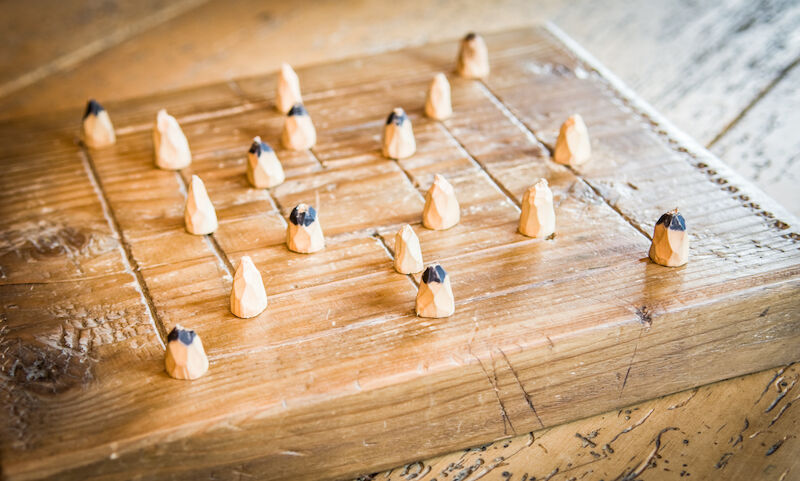Mill Games
Last updated: .
Mill games are a family of boardgames also known as Morris or Merels games. The main aim of any mill game is to try to form a row of three pieces, which is called a ‘mill’, and which usually allows the player to remove one of the opponent’s pieces from the board (usually not from another mill).
Most mill games are split into two phases of placement and movement, so that all pieces are placed on the board before any pieces are moved.

A game in progress, just after the placement phase has been finished, and all 18 pieces are on the board.
© Shutterstock.com/FooTToo : 120413827
Games
Many of the games overlap so much that they could be considered to be the same game. For example, Morabaraba as standardized by Mind Sports South Africa has only two small differences from Twelve Men’s Morris as standardized by the Weltmühlespiel Dachverband. However, I have chosen to describe it separately due to the interesting history and cultural context around the game.
The most important representative of the type is Nine Men’s Morris, and it is a good place to start if you have never played this type of game before.
Games on the large mill board
Two different large mill boards, one without diagonals, and one with diagonals.
© George Pollard, 🅭🅯🄏🄎
Morabaraba is a mill game played competitively in South Africa. It differs slightly from Twelve Men’s Morris.
Nine Men’s Morris is the most well-known, and can be viewed as the stereotypical mill game. Many variants are described on this page.
Twelve Men’s Morris is the most common form in the United States. Eleven Men’s Morris is a variant with one fewer piece per player.
Shax is a mill game from Somalia. It is distinguished by not permitting capturing during the placement phase.
Games on the medium mill board
Achi is a game from West Africa that features an additional way to form a mill.
[Five Men’s Morris] or [Six Men’s Morris] is a mid-sized version that is less common than the bigger or smaller games.
Games on the small mill board

The small mill board.
© George Pollard, 🅭🅯🄏🄎
Three Men’s Morris is a simple mill game that is known around the world.
Tic-Tac-Toe can be viewed as a degenerate mill game (and could derive from Three Men’s Morris?)
Other mill boards
Tri-Hex uses a non-standard board derived from that of tic-tac-toe.
Terminology
The general name for the game family:
Italian mulino, ‘mill’
Pieces: names for the pieces:
Mill: three pieces in a row:
Sotho molamu ‘staff’.C (p. 35)
Somali charri ‘halter’,D (p. 504)E (p. 130) saddex ‘three’,E (p. 130) or jare ‘cut’.F (p. 4)
Zulu isibhamu ‘gun’ – this is used to “shoot” the pieces (cows).
Cross-mill: a position where a mill can be formed every other move, with pieces in a cross shape (with one empty square between):
German Kreuzmühle ‘cross mill’.
Icelandic krossmylna ‘cross mill’ or vængjamylna ‘winged mill’ A (p. 139).
Running mill: a position where a mill can be formed on every move:
English:
German Zwickmühle ‘double mill’.
Sotho kgutla/khutla ‘to return’.K (p. 134)
Swiss figgi or figge (there is a saying that one has one’s «Figgi und Müli», meaning “to have two options open”).L
Corner: a position with three pieces in a corner, which cannot be prevented from forming a mill upon the next turn:
Other positions: unknown positions:
References
Fiske, Willard (). Chess in Iceland and in Icelandic literature, with historical notes on other table-games. The Florentine Typographical Society: Florence.
Mactaggart, John (). The Scottish Gallovidian Encyclopedia (2nd edition). Hamilton, Adams and Co.: London, UK.
Masiea, Joshua Rawley (). The Traditional Games of Basotho Children. Master’s thesis, University of Cape Town: Cape Town, South Africa.
Marin, G. (). ‘Somali Games’. The Journal of the Royal Anthropological Institute of Great Britain and Ireland vol. 61: pages 499–511.
Drake-Brockman, Ralph E. (). British Somaliland. Hurst & Blackett: London, UK. ark:/13960/t75t91r5n.
Davies, Rick (). ‘An Introduction to Shax’.
Baker, R. S. (). ‘Peg Meryll’. Associated Architectural Societies’ Reports & Papers vol. 11 (1): pages 127–134.
Murray, H. J. R. (). A History of Board-Games Other Than Chess. Oxford University Press: Oxford, England, UK. ISBN: 0-19-827401-7.
Cram, David, Jeffrey L. Forgeng, and Dorothy Johnston (). Francis Willughby’s Book of Games: a seventeenth-century treatise on sports, games and pastimes. Routledge: London & New York. ISBN: 978-1-85928-460-5. First published in 2003 by Ashgate Publishing.
Abbott, George Frederick (). Macedonian Folklore. Cambridge University Press: Cambridge, UK.
Mkele, N. (). ‘A Note on “Bantu Games”’. Journal of the National Institute for Personnel Research vol. 6 (3): pages 132–134.
Schweizerdeutsches Wörterbuch (). ‘Schweizerisches Idiotikon: Figgi und Müli haa’ [text in Swiss German] [archived]. Schweizerdeutsches Wörterbuch: Zürich, Switzerland.

